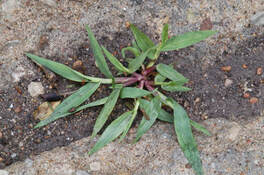 This is the time of year when people really notice crabgrass infestations. By far the best way to control crabgrass is to prevent it by maintaining a good, thick lawn. Crabgrass is an annual that must come up from seed each year and the seed must have light in order to germinate. If a lawn is thick enough that sunlight does not reach the soil, the crabgrass will not germinate. Under Kansas conditions it is not easy to maintain such a lawn; so many gardeners do the next best thing and apply a crabgrass preventer in the spring. Crabgrass preventers kill the seed as it germinates. Most do not have any effect on crabgrass that has already come up. If we are too late to apply a preventer, we do have other herbicides that will kill crabgrass plants including Ortho Weed-B-Gon Max +Crabgrass Control, Fertilome Weed-Out with Crabgrass Control, Monterey Crab-E-Rad and BioAdvanced Lawn Weed & Crabgrass Killer. Each contains quinclorac, which is a crabgrass herbicide, as well as other active ingredients that control broadleaf weeds. Quiclorac is an excellent crabgrass killer that controls not only crabgrass but also has good activity on foxtail and certain broadleaves such as field bindweed, black medic and clover. However, it does little to nothing to goosegrass. Fortunately, crabgrass starts declining about the middle of August. This is about the same time that cool- season grasses such as tall fescue and Kentucky bluegrass start to come out of their summer doldrums. By the first of September, the crabgrass will be less noticeable. Therefore, a small infestation is best ignored. Remember that crabgrass is a warm-season annual and will be killed by the first frost. (Ward Upham) 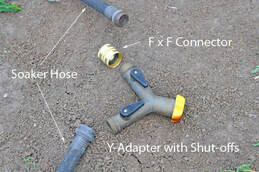 We mentioned in an accompanying article about using a soaker hose to water trees. We thought it might be helpful to provide more details. Soaker hoses are notorious for non-uniform watering. In other wor ds, you often receive too much water from one part of the hose and not enough from another. On small trees, circling the tree several time with the soaker hoses will even out the amount of water applied but this isn’t practical for larger trees. Hooking both the beginning and the end of the soaker hose to a Y-adapter helps equalize the pressure and therefore provide a more uniform watering. The specific parts you need are shown in the photo above and include the soaker hose, Y-adapter and female to female connector. It is also helpful if the Y-adapter has shut off valves so the volume of flow can be controlled. Too high a flow rate can allow water to run off rather than soak in. On larger trees, the soaker hose can circle the trunk at a distance within the dripline of the tree but at least ½ the distance to the dripline. The dripline of the tree is outermost reach of the branches. On smaller trees, you may circle the tree several times so that only soil which has tree roots will be watered. Soil should be wet at least 12 inches deep as 80% of a trees roots are in the top foot of soil. Use a metal rod, wooden dowel, electric fence post or something similar to check depth. Dry soil is much harder to push through than wet and your probe will stop when it hits dry soil. How long it takes water to reach a 12 inch depth varies depending on the rate of water flow and soil. Record the amount of time it takes to reach 12 inches the first time the tree is watered. After that, simply water for that same amount of time. (Ward Upham) 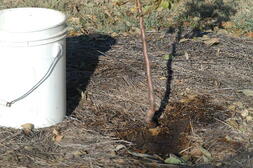 Newly planted trees have not established the extensive root system needed to absorb enough water during hot, dry, windy summers. Even trees two or three years old should receive special care. Deep, infrequent watering and mulching can help trees become established. Newly transplanted trees need at least 10 gallons of water per week, and on sandy soils they will need that much applied twice a week. The secret is getting that water to soak deeply into the soil, so it evaporates more slowly and is available to the tree’s roots longer. One way to do this is to drill a 1/8" hole in the side of a 5-gallon bucket and fill it with water. The hole should be near the bottom of the bucket. Let the water dribble out slowly next to the tree. Refill the bucket once after moving it to the opposite side of the tree. After this bucket empties, you have applied 10 gallons. Very large transplanted trees and trees that were transplanted two to three years ago will require more water. A perforated soaker hose or drip irrigation can be used to water a newly established bed or foundation planting. In sunbaked soil, you may need to rough up the surface with a hoe or tiller to get water to infiltrate easily. It may be helpful to set the kitchen oven timer, so you remember to move the hose or shut off the faucet. If you are seeing surface runoff, reduce the flow, or build a berm with at least a 4-foot diameter around the base of the tree to allow the water to percolate down through the soil, instead of spreading out. Regardless of method used, soil should be wet at least 12 inches deep. Use a metal rod, wooden dowel, electric fence post or something similar to check depth. Dry soil is much harder to push through than wet. (Ward Upham) 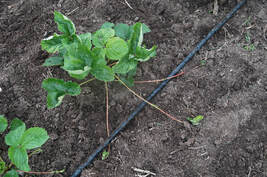 When temperatures exceed 90 degrees F, fruit plants lose water quickly. When this happens, moisture is withdrawn from the fruit to supply the tree. Stress from high temperatures, along with a moisture deficit in the root environment, may cause fruit to drop or fail to increase in size. The stress may also reduce the development of fruit buds for next year's fruit crop. If you have fruit plants such as trees, vines, canes, and such, check soil moisture at the roots. Insert a pointed metal or wood probe such as a wooden dowel, piece of rebar or a electric fence post to check the depth of watering. Even a long screwdriver works well for this. Push these into the soil with the goal of reaching 8 to 12 inches. This may not be possible if the soil is hard and dry. If you cannot reach the recommended depth, the plants should be irrigated to prevent drooping and promote fruit enlargement. Water can be added to the soil using sprinklers, soaker hose, drip irrigation, or even a small trickle of water running from the hose for a few hours. The amount of time you irrigate should depend upon the size of plants and the volume of water you are applying. Add enough moisture so you can easily penetrate the soil in the root area to the recommended depth. When hot, dry weather continues, continue to check soil moisture at least once a week. Strawberries have a shallow root system and may need to be watered more often – maybe twice a week during extreme weather. Also, newly planted fruit trees sited on sandy soils may also need water twice a week. (Ward Upham) 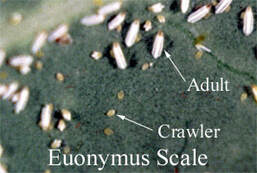 Euonymus scales look like small white cottony spots on affected euonymus foliage. Leaves eventually turn yellow and die as feeding continues. Males are white and elongated, and females are brown and oval shaped and about 1/16 inch long. Large numbers congregate on the undersides of leaves, twigs, and stems. About 60 days are required to complete a generation. In Kansas, there are several generations per year. Multiple treatments may be needed for good control. The crawler stage (young scale that have recently hatched) is when euonymus scale is most easily controlled. Therefore, check to be sure crawlers are present before treating. Since there are multiple generations per year, check for crawlers now. Spraying when crawlers are not present is ineffective. Double-sided tape or electrical tape smeared with petroleum jelly can be used to capture crawlers making them more easily seen. Use a magnifying lens to identify the very small crawlers. If nothing is moving, crawlers are not active yet. Labeled insecticides that are effective for the crawlers include malathion and acephate (Hi-Yield Acephate or Ortho Systemic Insect Killer), permethrin (Hi-Yield 38 Plus Turf Termite and Ornamental Insect Control, Hi-Yield Indoor/Outdoor Broad Use Insecticide and Lawn & Garden Insect Killer, Fertilome Indoor\Outdoor Multi-Purpose Insect Spray) or cyhalothrin (Spectracide Triazicide, Bonide Caterpillar Killer). Dormant oil can also be used for control in February to March to control overwintering scale. Temperatures need to be at least 40 degrees so the spray has a chance to dry before freezing. Overwintering females lay eggs that hatch in mid- to late- May or early June for the first generation. This period usually occurs when fringetrees, (Chionanthus spp.), cockspur hawthorn (Crataequs crusgalli), Beautybush (Kolkwitzia amabilis) and Late Lilac (Syringa villosa) are in bloom. Crawlers move to leaves and stems and begin to feed by sucking plant juices. Maturing males prefer leaves and females congregate on stems. Control is probably impossible for euonymus that has been heavily attacked and is in very poor health. Therefore, complete removal and destruction of these heavily infested plants (including roots) is suggested. (Ward Upham) 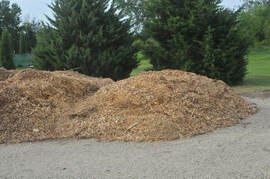 With many municipalities and tree service companies having wood chippers now, gardeners often are able to get chips free. We are sometimes asked our opinion about whether these make a good mulch. Some people have heard that these chips will tie up nitrogen so that the garden plants won't grow as well. If wood chips are used as a mulch, there is no cause for concern. However, if the chips are mixed with the soil, there can be a problem during the breakdown process. The microorganisms that break down the chips need a certain amount of nitrogen during the process. With most green material, there is enough nitrogen in the material itself to meet the needs of the microorganisms. However, nitrogen levels in wood chips are so low, the microorganisms must borrow it from the surrounding soil. This results in less nitrogen being available to the plants. However, when the raw organic material has been digested, the microorganisms die and release the nitrogen. Therefore, the nitrogen is not lost but is simply unavailable for plant use for a period of time. Again, this is only a concern if the wood chips are mixed into the soil. There is no problem with nitrogen tie-up if the chips are used as a mulch. However, one point should be kept in mind. These chips can be used by foraging termites as a bridge to homes and other structures. Termites are light and heat sensitive and will not bother the chips themselves if they are 3 inches deep or less. Therefore, watch the depth of these chips near the house or other buildings. Also leave a bare area several inches wide next to the house so that any termite activity is noticeable. (Ward Upham) 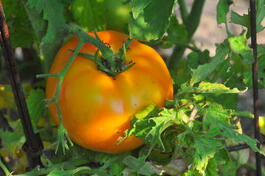 The hot weather we have had recently not only interferes with flower pollination (see accompanying article), but also can affect how quickly fruit matures. The best temperature for tomato growth and fruit development is 85 to 90F. When temperatures exceed 100 degrees, the plant goes into survival mode and concentrates on moving water. Fruit development slows to a crawl. When temperatures moderate, even to the low to mid 90s, the fruit will ripen more quickly. Tomato color can also be affected by heat. When temperatures rise above 95 degrees F, red pigments don't form properly though the orange and yellow pigments do. This results in orange fruit. This doesn't affect the edibility of the tomato, but often gardeners want that deep red color back. So, can we do anything to help our tomatoes ripen and have good color during extreme heat? Sure, there is. We can pick tomatoes in the “breaker” stage. Breaker stage tomatoes are those that have started to turn color. At this point, the tomato has cut itself off from the vine and nothing will be gained by keeping it on the plant. If tomatoes are picked at this stage and brought into an air-conditioned house, they will ripen more quickly and develop a good, red color. A temperature of 75 to 85 degrees F will work well. (Ward Upham) 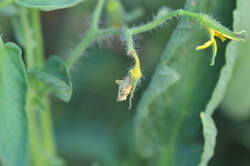 Temperatures that remain above 75 degrees F at night and day temperatures above 95 degrees F with dry, hot winds will cause poor fruit set on tomatoes though cherry tomatoes seem to be more heat tolerant than slicers. High temperatures interfere with pollen viability and/or cause excessive style growth leading to a lack of pollination. Tomatoes that have already formed are not affected. It usually takes about 3 weeks for tomato flowers to develop into fruit about the size of golf balls. Growth then becomes more rapid with the mature size being reached in an additional three to six weeks. A few more days are then needed to change color. Though there are "heat-set" slicing tomatoes such as Florida 91, Sun Leaper and Sun Master that will set fruit at higher temperatures, that difference is normally only 2 to 3 degrees. Cooler temperatures will allow flowers to resume fruit set. (Ward Upham) |
AuthorsCynthia Domenghini runs the Horticulture Response Center in the Department of Horticulture and Natural Resources at Kansas State University. Other contributors include K-State Extension Specialists. Archives
March 2024
Categories
All
|
| K-State Research and Extension Horticulture Newsletter |
|
 RSS Feed
RSS Feed
